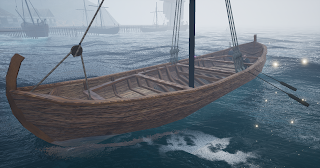Knarr: Port of Scarborough 1264
The Knarr is a personal favorite. Unlike the top-heavy Cog, this ship looks like it is made for the sea.
Skuldelev 1, an ocean going trader from 1030, and Ottar, a modern day reconstruction, have given us new insights into northern trading vessels during the early to high medieval period.
The 'Knarr' we have built for the Scarborough 1264 set is based on these vessels.
The Knarr is a solid boat. Our build is 16m long, 5m wide, 6 tons, sail 10 knots, oars 1-2 knots, with side planking at 2.5" - much greater than the older long boats. This trader could carry 60+ tons of trade goods with a crew of 5+ sailors (with the possibility of 4 oars). Unlike larger versions of the Knarr (perhaps including the massive but ill-fated White Ship and the Scarborough port-reeve's ship), the Knarr's shallow draught (<1.5m) would have allowed great flexibility in tidal and riverine waters.
It would have been ideal as a transport ship for the Danish and Norman invasion of England. I have tried a couple of horses on a temporary deck above one of the holds - on one of our build levels. Everyone fits, but my guess is that no-one would have been happy about a couple of Shire Horses on deck if the sea started to build).
The debate has a way to go, but it is suggested that the nefs/cogs of the Cinque Ports share a common lineage with the Knarr. Still, the northern ports would have had a different look and feel to the Southern Cinque Ports that favored the be-castled cog.
Here, a Knarr leaves the port in gentle weather late afternoon. In the distance, outside the East Sand Gate, fair stalls are being erected and we are rebuilding the port to include the port-reeves offices, more port storage and fish vendors. In time we will add (closer to the mouth of the Damyot) a spillway for boat building and repair - and the remnant wharfs from less kind times, for the use of those who fish, both bird, human and sea-mare.
Perhaps the ancient Borough Seal of Scarborough depicts a (perhaps slightly larger) version of this boat - together with provision for a fortified archer's post on the main mast. On a whim, we will ensure that the port-reeve has such a ship ready for use.
Run onto the beach for repair and stripped of running boards, here the interior detail of the large uncovered cargo holds are visible.
A first time for some of the crew and the rope handling was a bit dodgy. I have sent them back out to practice.
The sail here is made of squares made from plant stem fiber thrashed and combed into a whispy cloud of long strings of stem, formed into thread using a drop spindle, and then weaved into rectangles of cloth (a mix probably a bit rougher than linen).



















Comments